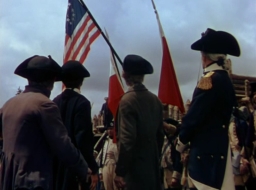|
Newest Reviews:
New Movies -
The Tunnel
V/H/S
The Tall Man
Mama Africa
Detention
Brake
Ted
Tomboy
Brownian Movement
Last Ride
[Rec]≥: Genesis
Hara-Kiri: Death of a Samurai
Indie Game: The Movie
Abraham Lincoln: Vampire Hunter
Old Movies -
Touki Bouki: The Journey of the Hyena
Drums Along the Mohawk
The Chase
The Heiress
Show
People
The Strange Affair of Uncle Harry
Pitfall
Driftwood
Miracle Mile
The Great Flamarion
Dark Habits
Archives -
Recap: 2000,
2001, 2002,
2003, 2004
, 2005, 2006,
2007 , 2008
, 2009 ,
2010 , 2011 ,
2012
All reviews alphabetically
All reviews by star rating
All reviews by release year
Masterpieces
Screening Log
Links
FAQ
E-mail me
HOME
| |
Drums Along the Mohawk (John Ford, 1939)
 Drums
Along the Mohawk is the least well-known but arguably strongest of director
John Fordís three 1939 features (Young
Mr. Lincoln and Stagecoach were
the others). Fordís first color film, it belies his famous lack of affinity for
the format, although more of the visual splendor here has to do with the
contrast between the horizontal plains and the vertical forests than the hues
used. In typical Fordian style, the focus is on the building of community
against terrible odds; this time the setting is New Yorkís Mohawk Valley in the
1770s. Still, among the diverse personalities that make up this motley society a
mindset prevails. Duty leads to detachment, as is typical in Ford, and there are
sterling examples here of resolute stoicism triumphing over hysteria. Most
notable is a scene in which a delirious Fonda returns home from battle while
Colbert, struggling to hold back her emotions implores him, ďDarling, donít talk
about it!Ē This same theme is flipped over along gender lines many times
throughout the film, even motoring the comic scenes, such as when Colbertís
character is about to give childbirth and the men scoff at a screaming woman
only become a bundle of nervous energy themselves. Character actress Edna May
Oliver (Oscar-nominated here) plays a straight talking old biddy and perhaps
epitomizes this pragmatic outlook. The natives might burn down her house, but
sheíll be damned if sheís giving up her bed. Drums
Along the Mohawk is the least well-known but arguably strongest of director
John Fordís three 1939 features (Young
Mr. Lincoln and Stagecoach were
the others). Fordís first color film, it belies his famous lack of affinity for
the format, although more of the visual splendor here has to do with the
contrast between the horizontal plains and the vertical forests than the hues
used. In typical Fordian style, the focus is on the building of community
against terrible odds; this time the setting is New Yorkís Mohawk Valley in the
1770s. Still, among the diverse personalities that make up this motley society a
mindset prevails. Duty leads to detachment, as is typical in Ford, and there are
sterling examples here of resolute stoicism triumphing over hysteria. Most
notable is a scene in which a delirious Fonda returns home from battle while
Colbert, struggling to hold back her emotions implores him, ďDarling, donít talk
about it!Ē This same theme is flipped over along gender lines many times
throughout the film, even motoring the comic scenes, such as when Colbertís
character is about to give childbirth and the men scoff at a screaming woman
only become a bundle of nervous energy themselves. Character actress Edna May
Oliver (Oscar-nominated here) plays a straight talking old biddy and perhaps
epitomizes this pragmatic outlook. The natives might burn down her house, but
sheíll be damned if sheís giving up her bed.
If Drums Along the
Mohawk has a liability, itís that the action, at least until the climactic
sequence in which Fondaís character outruns a pack of natives, is of a secondary
concern. Although the unique backdrop sets this film apart from Fordís most
famous ones, it is in many respects typical of his mature work, which limits the
sense of surprise for those who know it well. Its revelations feel like foregone
conclusions at times. This isnít to say that they lack power, however. The theme
of community, so central to Fordís oeuvre, takes on a deeply patriotic resonance
in the filmís final moments, as the battle-scarred pioneers of the region, by no
means supporters of the Revolutionary cause, see the new American flag in a
fresh light. It makes for a moment that dares you to mock it yet one that works,
saluting Native American and all, because we have borne witness to the struggle
that has come before.
73
Jeremy Heilman
08.16.12
|